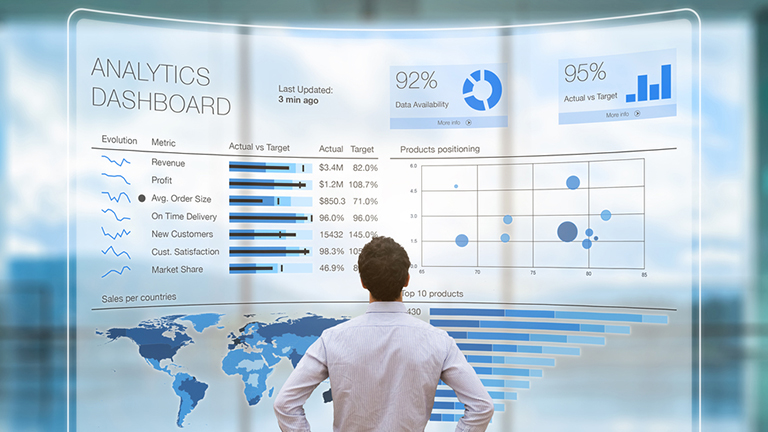7 Golden Rules of Designing Dashboards

With the increasing importance of data and analytics, dashboards have gained much popularity. They are present in many of the web and mobile apps we use daily. A dashboard is a visual representation of information to present complex information in an easy to understand format for its users. A dashboard provides an overview, with access to essential data, functions, and controls. A useful dashboard should be clear, meaningful, consistent and straightforward. There are different types of dashboards for different kinds of businesses. However, there are some golden rules or best practices for designing dashboards. Let’s take a look at a few of them!
1. Know your audience
The first and the most important step in designing a dashboard is to know about the audience for whom you are creating the dashboard. Focusing on the audience’s requirements simplifies the process of producing an outcome that they desire. Once you’ve learned about the user personas, you should seek an answer to – what will my users expect from this dashboard? Your audience level may vary from one to the other. You should then segment your audience and segregate the information accordingly as basic and advanced content.
2. Consider your end goal
Along with knowing the audience, it’s equally important to consider your end goal, even before you start putting your design elements in place. To successfully do so, you need to put yourself in your audience’s shoes.
The style in which the information should display depends directly on the context and device on which users will regularly access their dashboards. How will the dashboard be viewed, in an office or on the move? Will it be displayed as a presentation? All this will matter in deciding the design layout. If your dashboard is displayed as a presentation, make sure it contains all vital information within one page.
3. Choose relevant KPIs
Selecting the right Key Performance Indicators (KPIs) for your business needs is a must. Only by selecting the correct KPIs you will be able to create a genuinely useful dashboard design. It will help to shape the direction of designing dashboards as these metrics will display visual representations of relevant insights based on specific areas of the business. Once you’ve considered your target audience and determined your ultimate goals, you will be able to select the best KPIs for your dashboard.
4. Keep it responsive
It is essential to build responsive online dashboards that fit all types of screens, whether it’s a smartphone, a PC or a tablet. A responsive dashboard design allows the user to decide which data they want to focus on. An easily understood UI that enables the user to control which data needs to be front and center in the dashboard is the key to a responsive design.
5. Maintain a Proper Hierarchy
One of the most common mistakes in designing the dashboard is showcasing all the information as if it is equally important. Information with high-importance should be separate from the low-importance information. Use the size and position of content widgets to show the hierarchy of data.
By defining information levels, you can make it easier for the viewer to identify the most important information. Display more significant data on the top left. Move towards the bottom right direction with the data from more to less important level. You can also categorize all the information and display them in different views.
6. Choose the Right Layout
Useful metrics and well-thought-out charts are not the only aspects of designing dashboards. You need to choose an appropriate layout to place the charts on the dashboard. A visually organized dashboard helps the user to find the information they need easily. A poor layout forces the user to think more, and nobody likes to wreck their brains looking for data in a heap of charts and numbers.
The general rule is to display the key information first, on the top of the screen, upper left-hand corner. It is scientifically proven that most cultures read their written language from left to right and top to bottom. That means, people intuitively look at the upper-left part of a page first.
Another useful dashboard layout principle is to start with the big picture. The primary trend and the holistic view should be visible at a glance. After displaying the overview, you can go ahead with more detailed charts. Always group the charts based on a theme, with comparable metrics placed next to each other; it enhances the user experience. Jumping from sales data to marketing data, and then again to sales data is painstaking.
7. Keep It Simple While Designing Dashboards
The purpose of the dashboard is to display complex information understandable and straightforwardly. Don’t provide too much information upfront; it may be difficult to absorb for the user. Only include the most relevant information, at least on the initial screen.
When you have datasets that are easier to understand when seen together, present them in a single card. But don’t overdo it, as it will only end up confusing the user. The number of columns used to display the information must be as less as possible. Reduce the clutter by removing irrelevant content. Also, pay attention to your labels, legends and the font size, and color. It shouldn’t be hiding your charts but should be legible at the same time.
These dashboard design principles are beneficial, however, you should never stop learning and evolving. The ability to tweak and develop your designs in response to the changes around you will ensure your analytical success. Want to discuss more on dashboard designs? Talk to our design experts.

